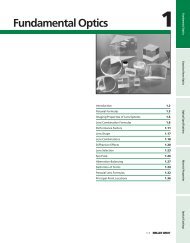Intel PXA250 and PXA210 Applications Processors
Intel PXA250 and PXA210 Applications Processors
Intel PXA250 and PXA210 Applications Processors
You also want an ePaper? Increase the reach of your titles
YUMPU automatically turns print PDFs into web optimized ePapers that Google loves.
System Memory Interface<br />
Table 2-8. Variable Latency I/O Interface AC Specifications (Sheet 2 of 2)<br />
Symbol<br />
Description<br />
MEMCKLK<br />
99.5 118.0 132.7 147.5 165.9<br />
Units<br />
Notes<br />
tvlioDSW<br />
tvlioDSWH<br />
tvlioDHW<br />
tvlioDHR<br />
tvlioRDYH<br />
MD(31:0), DQM(3:0) write data setup to<br />
nPWE asserted<br />
MD(31:0), DQM(3:0) write data setup to<br />
nPWE de-asserted<br />
MD(31:0), DQM(3:0) hold after nPWE<br />
de-asserted<br />
MD(31:0) read data hold after nOE deasserted<br />
RDY hold after nOE, nPWE deasserted<br />
nPWE, nOE high time between beats of<br />
tvlioNPWE<br />
write or read data<br />
NOTES:<br />
1. This number represents 1 MEMCLK period<br />
2. This number represents 2 MEMCLK periods<br />
10 8.5 7.5 6.8 6 ns, 1<br />
20 17 15 13.6 12 ns, 2<br />
10 8.5 7.5 6.8 6 ns, 1<br />
0 0 0 0 0 ns<br />
0 0 0 0 0 ns<br />
20 17 15 13.6 12 ns, 2<br />
2.6.5 External Logic for PCMCIA Implementation<br />
The <strong>PXA250</strong> applications processor requires external glue logic to complete the PCMCIA socket<br />
interface. Figure 2-4, “Expansion Card External Logic for a Two-Socket Configuration” on page 2-<br />
12 <strong>and</strong> Figure 2-5, “Expansion Card External Logic for a One-Socket Configuration” on page 2-13<br />
show general solutions for one <strong>and</strong> two socket configurations. Use GPIO or memory-mapped<br />
external registers to control the PCMCIA interface’s reset, power selection (V CC <strong>and</strong> V PP ), <strong>and</strong><br />
drive enables. These diagrams show the logical connections necessary to support hot insertion<br />
capability. For dual-voltage support, level shifting buffers are required for all the applications<br />
processor input signals. Hot insertion capability requires each socket be electrically isolated from<br />
the other <strong>and</strong> from the remainder of the memory system. If one or both of these features are not<br />
required, you may eliminate some of the logic shown in these diagrams. The applications processor<br />
allows either 1-socket or 2-socket solutions. In the 1-socket solution, only minimal glue logic is<br />
required (typically for the data transceivers, address buffers, <strong>and</strong> level shifting buffers.) To achieve<br />
this some of the signals are routed through dual-duty GPIO pins. The nOE of the transceivers is<br />
driven through the PSKTSEL pin, which is not needed in the one-socket solution. The DIR pin of<br />
the transceiver is driven through the RDnWR pin. A GPIO is used for the three-state signal of the<br />
address <strong>and</strong> nPWE lines. These signals are used for memories other than the card interface <strong>and</strong><br />
must be three-stated.<br />
Note:<br />
Note:<br />
For 2.5 V VCCN, 5 V to 2.5 V level shifters are required.<br />
PCMCIA is only implemented on the <strong>PXA250</strong> applications processor.<br />
In the 2-socket solution, all pins assume their normal duties <strong>and</strong> glue logic is necessary for proper<br />
operation of the system. The pull-ups shown are included for compliance with PC Card St<strong>and</strong>ard -<br />
Volume 2 - Electrical Specification. Remove power from these pull-ups during sleep to avoid<br />
unnecessary power consumption. Refer to Table 2-9 for the PCMCIA or compact Flash card<br />
interface AC specifications.<br />
<strong>PXA250</strong> <strong>and</strong> <strong>PXA210</strong> <strong>Applications</strong> <strong>Processors</strong> Design Guide 2-11
















